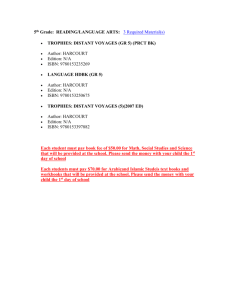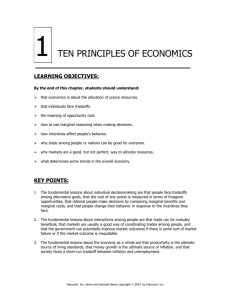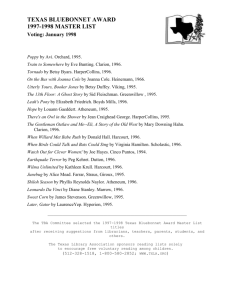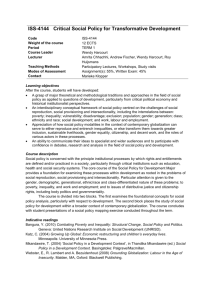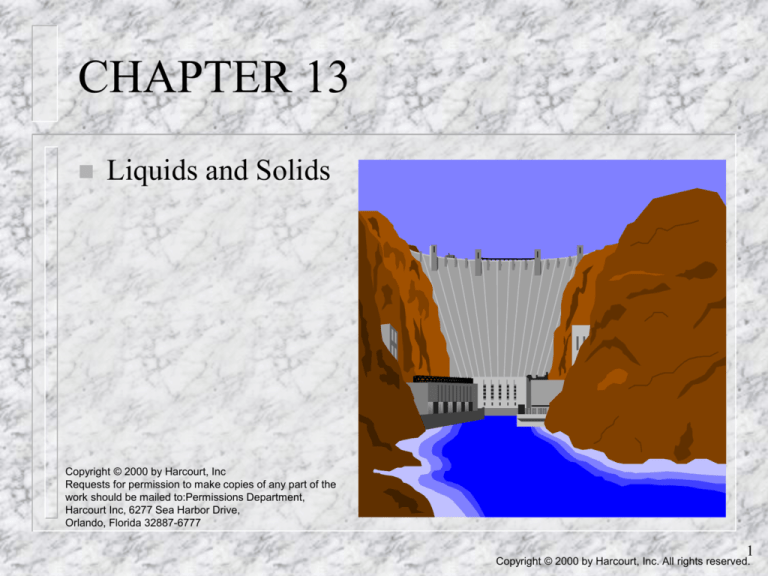
CHAPTER 13
Liquids and Solids
Copyright © 2000 by Harcourt, Inc
Requests for permission to make copies of any part of the
work should be mailed to:Permissions Department,
Harcourt Inc, 6277 Sea Harbor Drive,
Orlando, Florida 32887-6777
1
Copyright © 2000 by Harcourt, Inc. All rights reserved.
Chapter Goals
Kinetic-Molecular Description of Liquids & Solids
Intermolecular Attractions & Phase Changes
Properties of Liquids
– Viscosity, Surface Tension, Capillary Action
– Evaporation, Vapor Pressure,
– Boiling Points & Distillation, Heat transfer
Properties of Solids
– Melting Points, Heat Transfer
– Sublimation & Vapor Pressure
– Phase Diagrams, Amorphous & Crystalline Solids
– Crystal Structures, Bonding in Solids, Band Theory
Synthesis Question
2
Copyright © 2000 by Harcourt, Inc. All rights reserved.
Kinetic-Molecular Description of
Liquids & Solids
Solids & liquids are condensed states
–
–
Liquids & gases are fluids
–
atoms, ions, molecules are close to one another
highly incompressible
easily flow
Intermolecular attractions in liquids &
solids are strong
3
Copyright © 2000 by Harcourt, Inc. All rights reserved.
Kinetic-Molecular Description of
Liquids & Solids
gas
cool
heat
liquid
cool
solid
heat
4
Copyright © 2000 by Harcourt, Inc. All rights reserved.
Kinetic-Molecular Description of
Liquids & Solids
strengths of interactions among particles &
degree of ordering of particles
Gases< Liquids < Solids
Miscible liquids diffuse into one another
–
they are soluble in each other
for example:
–
–
water/alcohol
gasoline/motor oil
5
Copyright © 2000 by Harcourt, Inc. All rights reserved.
Kinetic-Molecular Description of
Liquids & Solids
Immiscible liquids do not diffuse into each
other
–
they are insoluble in each other
for example:
–
–
water/oil
water/cyclohexane
6
Copyright © 2000 by Harcourt, Inc. All rights reserved.
Intermolecular Attractions and
Phase Changes
Ion-ion interactions
–
force of attraction between two oppositely
charged ions is determined by Coulomb’s law
q q
F
+
d
-
2
7
Copyright © 2000 by Harcourt, Inc. All rights reserved.
Intermolecular Attractions and
Phase Changes
energy of attraction between two ions is given
by:
+
-
E =
q q
Fd =
d
q q
=
+
d
2
-
d
8
Copyright © 2000 by Harcourt, Inc. All rights reserved.
Intermolecular Attractions and
Phase Changes
Coulomb’s law & the attraction energy
determine:
–
–
melting & boiling points of ionic compounds
the solubility of ionic compounds
Example 13-1: Arrange the following ionic
compounds in the expected order of
increasing melting and boiling points.
NaF, CaO, CaF2
you do it
What important points must you consider?
9
Copyright © 2000 by Harcourt, Inc. All rights reserved.
Intermolecular Attractions and
Phase Changes
Dipole-dipole interactions
–
consider NH3 a very polar molecule
11
Copyright © 2000 by Harcourt, Inc. All rights reserved.
Intermolecular Attractions and
Phase Changes
Hydrogen bonding
–
consider H2O
12
Copyright © 2000 by Harcourt, Inc. All rights reserved.
Intermolecular Attractions and
Phase Changes
13
Copyright © 2000 by Harcourt, Inc. All rights reserved.
Intermolecular Attractions and
Phase Changes
London Forces
very weak
only attractive force in nonpolar molecules
consider Ar
isolated atom
14
Copyright © 2000 by Harcourt, Inc. All rights reserved.
Intermolecular Attractions and
Phase Changes
Group of Ar molecules
temporary dipole induces other dipoles
15
Copyright © 2000 by Harcourt, Inc. All rights reserved.
The Liquid State
Viscosity - resistance to flow
water vs. molasses
you buy oil for your car based on this property
Ostwald viscometer used to measure this
property
16
Copyright © 2000 by Harcourt, Inc. All rights reserved.
The Liquid State
Surface Tension - measure of the unequal
attractions that occur at the surface of a
liquid
molecules at surface are attracted unevenly
–
–
water bugs
floating razor blades
17
Copyright © 2000 by Harcourt, Inc. All rights reserved.
The Liquid State
Capillary Action - ability of a liquid to rise
(or fall) in a glass tube
cohesive forces - hold liquids together
adhesive forces - forces between a liquid
and another surface
–
–
capillary rise implies adhesive > cohesive
capillary fall implies cohesive > adhesive
18
Copyright © 2000 by Harcourt, Inc. All rights reserved.
The Liquid State
Capillary Action
water
mercury
19
Copyright © 2000 by Harcourt, Inc. All rights reserved.
The Liquid State
Evaporation
–
–
process in which molecules escape from the surface
of a liquid
T dependent
20
Copyright © 2000 by Harcourt, Inc. All rights reserved.
The Liquid State
Evaporation
21
Copyright © 2000 by Harcourt, Inc. All rights reserved.
The Liquid State
Vapor Pressure
–
pressure exerted by a liquid’s vapor on its surface
at equilibrium
Vap. Press. (torr) for 3 Liquids
0oC
20oC 30oC
diethyl ether 185 442 647
ethanol
12 44 74
water
5 18 32
Norm. B.P.
36oC
78oC
100oC
22
Copyright © 2000 by Harcourt, Inc. All rights reserved.
The Liquid State
Vapor Pressure
23
Copyright © 2000 by Harcourt, Inc. All rights reserved.
The Liquid State
Boiling Points & Distillation
–
–
boiling point is temperature at which the
liquid’s vapor pressure is equal to applied
pressure
normal boiling point is boiling point @ 1 atm
distillation is a method we use to separate
mixtures of liquids based on their
differences in boiling points
24
Copyright © 2000 by Harcourt, Inc. All rights reserved.
The Liquid State
Distillation
–
–
process in which a mixture or solution is
separated into its components on the basis of
the differences in boiling points of the
components
Distillation is another vapor pressure
phenomenon.
25
Copyright © 2000 by Harcourt, Inc. All rights reserved.
The Liquid State
Heat Transfer Involving Liquids
–
from Chapter 1
q = m C T
Example 13-2: How much heat is released by 200
g of H2O as it cools from 85.0oC to 40.0oC?
The specific heat of water is 4.184 J/goC.
you do it
26
Copyright © 2000 by Harcourt, Inc. All rights reserved.
The Liquid State
molar heat capacity - amount of heat required
to raise the T of one mole of a substance one
degree C
Example 13-3: The molar heat capacity of
ethyl alcohol, C2H5OH, is 113 J/moloC. How
much heat is required to raise the T of 125 g
of ethyl alcohol from 20.0oC to 30.0oC?
1 mol C2H5OH = 46.0 g
you do it
28
Copyright © 2000 by Harcourt, Inc. All rights reserved.
The Liquid State
energy associated with changes of state
heat of vaporization
amount of heat required to change 1 g of a
liquid substance to a gas at constant T
units of J/g
heat of condensation
reverse of heat of vaporization
o
+2260 J
o
1.00 g H2O(l) @ 100 C 1.00 g H2O(g) @ 100 C
-2260 J
30
Copyright © 2000 by Harcourt, Inc. All rights reserved.
The Liquid State
molar heat of vaporization or Hvap
amount of heat required to change 1 mol of a
liquid to a gas at constant T
units of J/mol
molar heat of condensation
reverse of molar heat of vaporization
o
+40.7 kJ
o
1.00 mol H2O(l) @ 100 C 1.00 mol H2O(g) @ 100 C
-40.7 kJ
31
Copyright © 2000 by Harcourt, Inc. All rights reserved.
The Liquid State
32
Copyright © 2000 by Harcourt, Inc. All rights reserved.
The Liquid State
Example 13-4: How many joules of energy
must be absorbed by 500 g of H2O at 50.0oC
to convert it to steam at 120oC? The molar
heat of vaporization of water is 40.7 kJ/mol
and the molar heat capacities of liquid water
and steam are 75.3 J/mol oC and 36.4 J/mol
oC, respectively.
33
Copyright © 2000 by Harcourt, Inc. All rights reserved.
The Liquid State
1 mol H2O
? mol = 500 g H2O
278
. mol H2O
18 g H2O
o
1st let's calculate the heat required to warm water from 50 to 100 C
753
. J
o
5
? J = 27.8 mol
1000
.
500
.
C
105
.
10
J
o
mol C
34
Copyright © 2000 by Harcourt, Inc. All rights reserved.
The Liquid State
2nd let’s calculate the energy required to boil the water
40.7 103 J
5
? J = 27.8 mol
1131
.
10
J
mol
35
Copyright © 2000 by Harcourt, Inc. All rights reserved.
The Liquid State
2nd let’s calculate the energy required to boil the water
40.7 103
? J = 27.8 mol
mol
J
5
. 10 J
1131
3rd let’s calculate the heat required to heat steam from
100 to 120oC
36.4 J
o
5
? J = 27.8 mol
120.0
-100.0
C
0
.
20
10
J
o
mol C
36
Copyright © 2000 by Harcourt, Inc. All rights reserved.
The Liquid State
total amount of energy for this process is the sum of
the 3 pieces we have calculated
. 10 J 1131
. 10 J 0.20 10 J
105
5
5
5
12.56 105 J or 1.26 103 kJ
37
Copyright © 2000 by Harcourt, Inc. All rights reserved.
The Liquid State
Example 13-5: If 45.0 g of steam at 140oC
is slowly bubbled into 450 g of water at
50.0oC in an insulated container, can all the
steam be condensed?
you do it
38
Copyright © 2000 by Harcourt, Inc. All rights reserved.
The Liquid State
Clausius-Clapeyron equation
–
–
–
determine vapor pressure of a liquid at a new T
determine what T we must heat something to get a
specified vapor pressure
way to determine Hvap if we know pressure at 2 T’s
P2 H vap 1 1
ln
R T1 T2
P1
42
Copyright © 2000 by Harcourt, Inc. All rights reserved.
The Liquid State
In Denver the normal atmospheric pressure is 630
torr. At what temperature does water boil in
Denver?
P2 H vap 1 1
ln
R T1 T2
P1
3 J
40
.
7
10
630
torr
1
1
mol
ln
760 torr
8.314 J K mol 373 K T2
1
ln 0.829 4895 0.002681
T2
43
Copyright © 2000 by Harcourt, Inc. All rights reserved.
The Liquid State
0188
.
1
0.002681
4895
T2
3.83 10
5
3.83 10
5
1
0.002681
T2
1
0.002681
T2
1
0.00272
T2
T2 368 K or 95o C
44
Copyright © 2000 by Harcourt, Inc. All rights reserved.
The Liquid State
Boiling Points of Various Kinds of Liquids
Gas
MW
BP(oC)
He
4
-269
Ne
20
-246
Ar
40
-186
Kr
84
-153
Xe
131
-107
Rn
222
-62
45
Copyright © 2000 by Harcourt, Inc. All rights reserved.
The Liquid State
0
4
20
40
84
131
222
-50
-100
BP-150
-200
-250
-300
MW
46
Copyright © 2000 by Harcourt, Inc. All rights reserved.
The Liquid State
o
Compound MW(amu) B.P.( C)
CH4
16
-161
C2H6
30
-88
C3H8
44
-42
n-C4H10
58
-0.6
n-C5H12
72
+36
47
Copyright © 2000 by Harcourt, Inc. All rights reserved.
The Liquid State
50
0
16
30
44
58
72
-50
BP
-100
-150
-200
MW
48
Copyright © 2000 by Harcourt, Inc. All rights reserved.
The Liquid State
o
Compound
MW(amu)
B.P.( C)
HF
20
19.5
HCl
37
-85.0
HBr
81
-67.0
HI
128
-34.0
49
Copyright © 2000 by Harcourt, Inc. All rights reserved.
The Liquid State
40 HF
20
0
BP
-20 20
37
81
128
HI
-40
-60
HBr
-80
-100
HCl
MW
50
Copyright © 2000 by Harcourt, Inc. All rights reserved.
The Liquid State
Compound
MW(amu)
o
B.P.( C)
H2O
18
100
H2S
34
- 61
H2Se
81
- 42
H2Te
130
-2
51
Copyright © 2000 by Harcourt, Inc. All rights reserved.
The Liquid State
120
100
H2O
80
60
40
20
BP
0
-20 18
34
81
130
H2Te
-40
-60
H2Se
-80
H2S
MW
52
Copyright © 2000 by Harcourt, Inc. All rights reserved.
The Liquid State
Example 13-6: Arrange the following
substances in order of increasing boiling
points.
C2H6, NH3, Ar, NaCl, AsH3
you do it
53
Copyright © 2000 by Harcourt, Inc. All rights reserved.
The Solid State
Normal Melting Point
–
–
T at which the solid melts (liquid and solid in
equilibrium) at 1 atm of pressure
melting point increases as intermolecular
attractions increase
55
Copyright © 2000 by Harcourt, Inc. All rights reserved.
Heat Transfer Involving Solids
heat of fusion
amount of heat required to melt one gram of a
solid at its melting point at constant T
334 J
1.00 g H2O (s) @ 0 C
1.00 g H2O (l) @ 0 C
o
o
heat of crystallization
reverse of heat of fusion
56
Copyright © 2000 by Harcourt, Inc. All rights reserved.
Heat Transfer Involving Solids
molar heat of fusion
amount of heat required to melt a mole of a
substance at its melting point H fusion
molar heat of crystallization
reverse of molar heat of fusion Hcrystallization
6012 J
1.00 mol H2O (s) @ 0o C
1.00 mol H2O (l) @ 0o C
57
Copyright © 2000 by Harcourt, Inc. All rights reserved.
Heat Transfer Involving Solids
Summary of heats of transformation of water
o
+2260 J
o
1.00 g H2O(l) @ 100 C 1.00 g H2O(g) @ 100 C
-2260 J
334 J
1.00 g H2O (s) @ 0 C
1.00 g H2O (l) @ 0 C
o
o
58
Copyright © 2000 by Harcourt, Inc. All rights reserved.
Heat Transfer Involving Solids
Example 11-7: Calculate the amount of heat
required to convert 150.0 g of ice at -10.0oC
to water at 40.0oC.
specific heat of ice is 2.09 J/goC
you do it
59
Copyright © 2000 by Harcourt, Inc. All rights reserved.
Sublimation & Vapor Pressure
of Solids
Sublimation
–
–
solid transforms directly to vapor
solid CO2 or “dry” ice
sublimation
solid
gas
deposition
61
Copyright © 2000 by Harcourt, Inc. All rights reserved.
Phase Diagrams (P vs T)
convenient way to display all of the different
phases of a substance
phase
diagram for
water
–
62
Copyright © 2000 by Harcourt, Inc. All rights reserved.
Phase Diagrams (P vs T)
phase
diagram
for
carbon
dioxide
63
Copyright © 2000 by Harcourt, Inc. All rights reserved.
Amorphous & Crystalline Solids
Amorphous solids do not have a well
ordered structure
paraffin, glasses
Crystalline solids have well defined
structures that consist of extended array of
repeating units
give X-ray difraction patterns
see Bragg equation in book
64
Copyright © 2000 by Harcourt, Inc. All rights reserved.
Structure of Crystals
unit cell - smallest repeating unit of a
crystal
bricks are repeating units for buildings
7 basic crystal systems
65
Copyright © 2000 by Harcourt, Inc. All rights reserved.
Structure of Crystals
Simple
cubic
66
Copyright © 2000 by Harcourt, Inc. All rights reserved.
Structure of Crystals
Simple cubic
–
–
each particle at a corner is shared by 8 unit cells
1 unit cell contains 8(1/8) = 1 particle
67
Copyright © 2000 by Harcourt, Inc. All rights reserved.
Structure of Crystals
Body centered cubic (bcc)
–
–
8 corners + 1 particle in center of cell
1 unit cell contains 8(1/8) + 1 = 2 particles
68
Copyright © 2000 by Harcourt, Inc. All rights reserved.
Structure of Crystals
Face
centered
cubic
(fcc)
69
Copyright © 2000 by Harcourt, Inc. All rights reserved.
Structure of Crystals
Face centered cubic (fcc)
–
–
8 corners + 6 faces
1 unit cell contains 8(1/8) + 6(1/2) = 4 particles
70
Copyright © 2000 by Harcourt, Inc. All rights reserved.
Bonding in Solids
Molecular Solids
–
–
–
molecules occupy unit cells
low melting points,volatile & insulators
examples:
water,
sugar, carbon dioxide, benzene
71
Copyright © 2000 by Harcourt, Inc. All rights reserved.
Bonding in Solids
Covalent Solids
–
–
atoms that are covalently bonded to one another
examples:
SiO2
(sand), diamond, graphite, SiC
72
Copyright © 2000 by Harcourt, Inc. All rights reserved.
Bonding in Solids
Ionic Solids
–
–
ions occupy the unit cell
examples:
CsCl,
NaCl, ZnS
73
Copyright © 2000 by Harcourt, Inc. All rights reserved.
Bonding in Solids
Metallic Solids
–
–
–
positively charged nuclei surrounded by a sea
of electrons
positive ions occupy lattice positions
examples:
Na,
Li, Au, Ag, ……..
74
Copyright © 2000 by Harcourt, Inc. All rights reserved.
Bonding in Solids
Variations in Melting Points
Molecular Solids
Compound
Melting Point (oC)
ice
0
ammonia
-77.7
benzene, C6H6
5.5
napthalene, C10H8
80.6
benzoic acid, C6H5CO2H 122.4
75
Copyright © 2000 by Harcourt, Inc. All rights reserved.
Bonding in Solids
Covalent Solids
Substance
sand, SiO2
carborundum, SiC
diamond
graphite
Melting Point (oC)
1713
~2700
>3550
3652-3697
76
Copyright © 2000 by Harcourt, Inc. All rights reserved.
Bonding in Solids
Ionic Solids
Compound
LiF
LiCl
LiBr
LiI
CaF2
CaCl2
CaBr2
CaI2
Melting Point (oC)
842
614
547
450
1360
772
730
740
77
Copyright © 2000 by Harcourt, Inc. All rights reserved.
Bonding in Solids
Metallic Solids
Metal
Na
Pb
Al
Cu
Fe
W
Melting Point (oC)
98
328
660
1083
1535
3410
78
Copyright © 2000 by Harcourt, Inc. All rights reserved.
Unit Cell Problem
A group IVA element with a density of
11.35 g/cm3 crystallizes in a facecentered cubic lattice whose unit cell
edge length is 4.95 A. Calculate the
element’s atomic weight. What is the
atomic radius of this element?
79
Copyright © 2000 by Harcourt, Inc. All rights reserved.
Unit Cell Problem
fcc has 4 atoms per unit cell
determine the volume of a single unit cell
0
1 A = 10
-8
0
cm 4.95 A 4.95 10
fcc has cubic dimensions so V = l
4.95 10
-8
cm
3
121
. 10
22
cm
-8
cm
3
3
80
Copyright © 2000 by Harcourt, Inc. All rights reserved.
Unit Cell Problem
use density to determine the mass of a unit cell
determine the mass of one atom in a unit cell
121
. 1022 cm3 1135
. g / cm3 138
. 1021 g / unit cell
in fcc there are 4 atoms per unit cell
thus the mass of one atom is
138
. 1021 g
344
. 1022 g / atom
4
81
Copyright © 2000 by Harcourt, Inc. All rights reserved.
Unit Cell Problem
determine the mass of 1 mole of these atoms
344
. 1022 g / atom 6022
. 1023 atoms / mole 2072
. g / mole
Pb has a molar mass of 207.2 g / mol
82
Copyright © 2000 by Harcourt, Inc. All rights reserved.
Unit Cell Problem
determine the radius of a Pb atom requires some
geometry from high school
notice there are 4 radii on the diagonal
83
Copyright © 2000 by Harcourt, Inc. All rights reserved.
Unit Cell Problem
determine the diagonal length then divide by 4 to
get atomic radius
diagonal =
2 4.95 10 cm
-8
700
. 10 cm
-8
-8
700
.
10
cm
radius =
175
. 10 cm
4
-8
84
Copyright © 2000 by Harcourt, Inc. All rights reserved.
Band Theory of Metals
Na’s 3s orbitals can interact to produce
overlapping orbitals
85
Copyright © 2000 by Harcourt, Inc. All rights reserved.
Band Theory of Metals
Can also overlap with unfilled 3p orbitals
86
Copyright © 2000 by Harcourt, Inc. All rights reserved.
Band Theory of Metals
Insulators have a large gap - forbidden zone
Semiconductors have a small gap
87
Copyright © 2000 by Harcourt, Inc. All rights reserved.
Synthesis Question
Maxwell House Coffee Company
decaffeinates its coffee beans using an
extractor that is 7.0 feet in diameter and
70.0 feet long. Supercritical carbon
dioxide at a pressure of 300.0 atm and
temperature of 100.00C is passed through
the stainless steel extractor. The extraction
vessel contains 100,000 pounds of coffee
beans soaked in water until they have a
water content of 50%.
88
Copyright © 2000 by Harcourt, Inc. All rights reserved.
Synthesis Question
This process removes 90% of the caffeine in
a single pass of the beans through the
extractor. Carbon dioxide that has passed
over the coffee is then directed into a water
column that washes the caffeine from the
supercritical CO2. How many moles of
carbon dioxide are present in the extractor?
89
Copyright © 2000 by Harcourt, Inc. All rights reserved.
Synthesis Question
Diameter of vessel (7.0 ft)(30.48cm/ft) 213.4 cm
Radius of vessel 213.4 cm/2 106.7 cm
Length of vessel (70.0 ft)(30.48cm/ft) 2134 cm
Volume of vessel r 2 h (3.1416)(106.7cm)2 (2134cm)
(7.633107 cm3 )(1 mL/cm3 )(1 L/1000 mL)
7.633104 L
90
Copyright © 2000 by Harcourt, Inc. All rights reserved.
Synthesis Question
PV nRT
n PV
300 atm 7.63310 L
RT 0.08206 L atm mol K 373 K
4
n 748,000 mol of CO 2
91
Copyright © 2000 by Harcourt, Inc. All rights reserved.
Group Question
How many CO2 molecules are there in 1.0
cm3 of the Maxwell House Coffee Company
extractor? How many more CO2 molecules
are there in a cm3 of the supercritical fluid
in the Maxwell House extractor than in a
mole of CO2 at STP?
92
Copyright © 2000 by Harcourt, Inc. All rights reserved.
Chapter Goals
Kinetic-Molecular Description of Liquids &
Solids
Intermolecular Attractions & Phase Changes
Properties of Liquids
–
–
–
Viscosity, Surface Tension, Capillary Action
Evaporation, Vapor Pressure,
Boiling Points & Distillation, Heat transfer
Properties of Solids
–
–
–
–
Melting Points, Heat Transfer
Sublimation & Vapor Pressure
Phase Diagrams, Amorphous & Crystalline Solids
Crystal Structures, Bonding in Solids, Band
Theory
93
Copyright © 2000 by Harcourt, Inc. All rights reserved.
End of Chapter 13
Our understanding of
Band Theory was a
major breakthrough
in semiconductor
knowledge.
Why computers
work!
94
Copyright © 2000 by Harcourt, Inc. All rights reserved.


